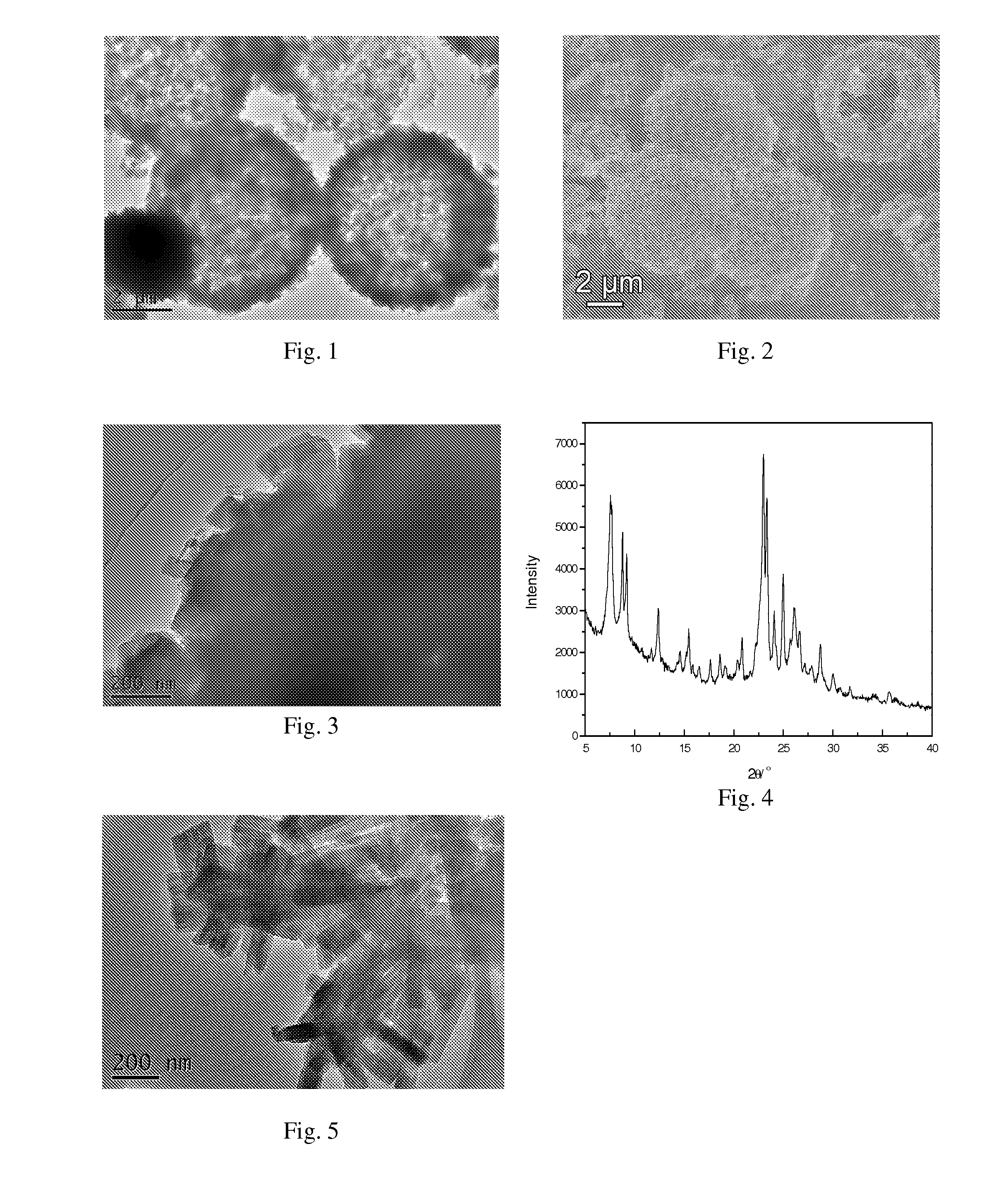Hollow spherical zeolite im-5 and preparation method therefor
a technology of hollow sphere and zeolite, which is applied in the field of hollow sphere and molecular sieve, can solve the problems of poor controllability and relatively high cost, easy to break the hollow sphere, and complicated operation steps
- Summary
- Abstract
- Description
- Claims
- Application Information
AI Technical Summary
Benefits of technology
Problems solved by technology
Method used
Image
Examples
example 1
[0037]Sodium hydroxide, 1,1 ′-(pentamethylene) bis-(1-methylpyrrolidinium) bromide, aluminum nitrate, water, white carbon and cetyl trimethylammonium bromide (CTAB) were mixed, according to molar ratios calculated based on the following species as follows: SiO2 / Al2O3=40, OH− / SiO2=0.62, R / SiO2=0.45, H2O / SiO2=50, and R / CTAB=0.7. The mixture obtained was then stirred in a water bath at a temperature of 60 degrees C. to be a homogeneous sol, which sol was kept at the constant temperature for 12 hours with stirring for pre-gelation. Subsequently, the gel was transferred into a hydrothermal reactor, heated to 165 degrees C., hydrothermally crystallized for 10 days, then cooled naturally, filtered and dried to obtain the as-synthesized products powder. By the XRD measurement, the products obtained were all well crystallized IM-5 molecular sieve, which were hollow spheres observed for the morphology with the TEM at low range, having an outer diameter of about 5 μm; while observed with the t...
example 2
[0038]Sodium hydroxide, 1,1 ′-(pentamethylene) bis-(1-methylpyrrolidinium) bromide, aluminum nitrate, water, white carbon and cetyl trimethylammonium bromide were mixed, according to molar ratios calculated based on the following species as follows: SiO2 / Al2O3=50, OH− / SiO2=0.70, R / SiO2=0.40, H2O / SiO2=65, and R / CTAB=1.0. The mixture obtained was then stirred in a water bath at a temperature of 60 degrees C. to be a homogeneous sol, which sol was kept at the constant temperature for 12 hours with stirring for pre-gelation. Subsequently, the gel was transferred into a hydrothermal reactor, heated to 170 degrees C., hydrothermally crystallized for 8 days, then cooled naturally, filtered and dried to provide a molecular sieve coarse powder. By the XRD measurement, the products obtained were all well crystallized IM-5 molecular sieve, which were hollow spheres observed for the morphology with the TEM at low range, having an outer diameter of about 8 μm; while observed with the transmissio...
example 3
[0039]Sodium hydroxide, 1,1 ′-(pentamethylene) bis-(1-methylpyrrolidinium) bromide, aluminum nitrate, water, white carbon and dodecyl trimethylammonium bromide (DTAB) were mixed, according to molar ratios calculated based on the following species as follows: SiO2 / Al2O3=70, OH− / SiO2=0.73, R / SiO2=0.45, H2O / SiO2=85, and R / DTAB=1.4. The mixture obtained was then stirred in a water bath at a temperature of 60 degrees C. to be a homogeneous sol, which sol was kept at the constant temperature for 20 hours with stirring for pre-gelation. Subsequently, the gel was transferred into a hydrothermal reactor, heated to 175 degrees C., hydrothermal crystallized for 7 days, then cooled naturally, filtered and dried to provide a molecular sieve coarse powder. By the XRD measurement, the products obtained were all well crystallized IM-5 molecular sieve, which were hollow spheres observed for the morphology with the TEM at low range, having an outer diameter of about 4 μm; while observed with the tran...
PUM
| Property | Measurement | Unit |
|---|---|---|
| outer diameter | aaaaa | aaaaa |
| outer diameter | aaaaa | aaaaa |
| outer diameter | aaaaa | aaaaa |
Abstract
Description
Claims
Application Information
 Login to View More
Login to View More - R&D
- Intellectual Property
- Life Sciences
- Materials
- Tech Scout
- Unparalleled Data Quality
- Higher Quality Content
- 60% Fewer Hallucinations
Browse by: Latest US Patents, China's latest patents, Technical Efficacy Thesaurus, Application Domain, Technology Topic, Popular Technical Reports.
© 2025 PatSnap. All rights reserved.Legal|Privacy policy|Modern Slavery Act Transparency Statement|Sitemap|About US| Contact US: help@patsnap.com


